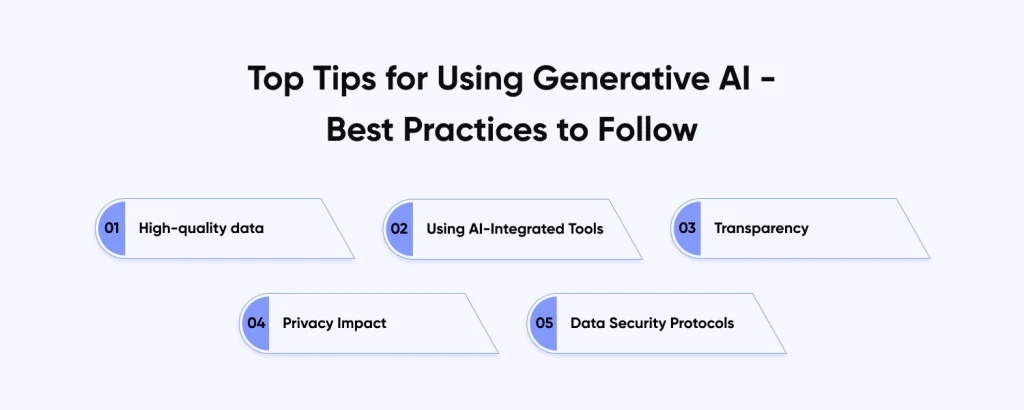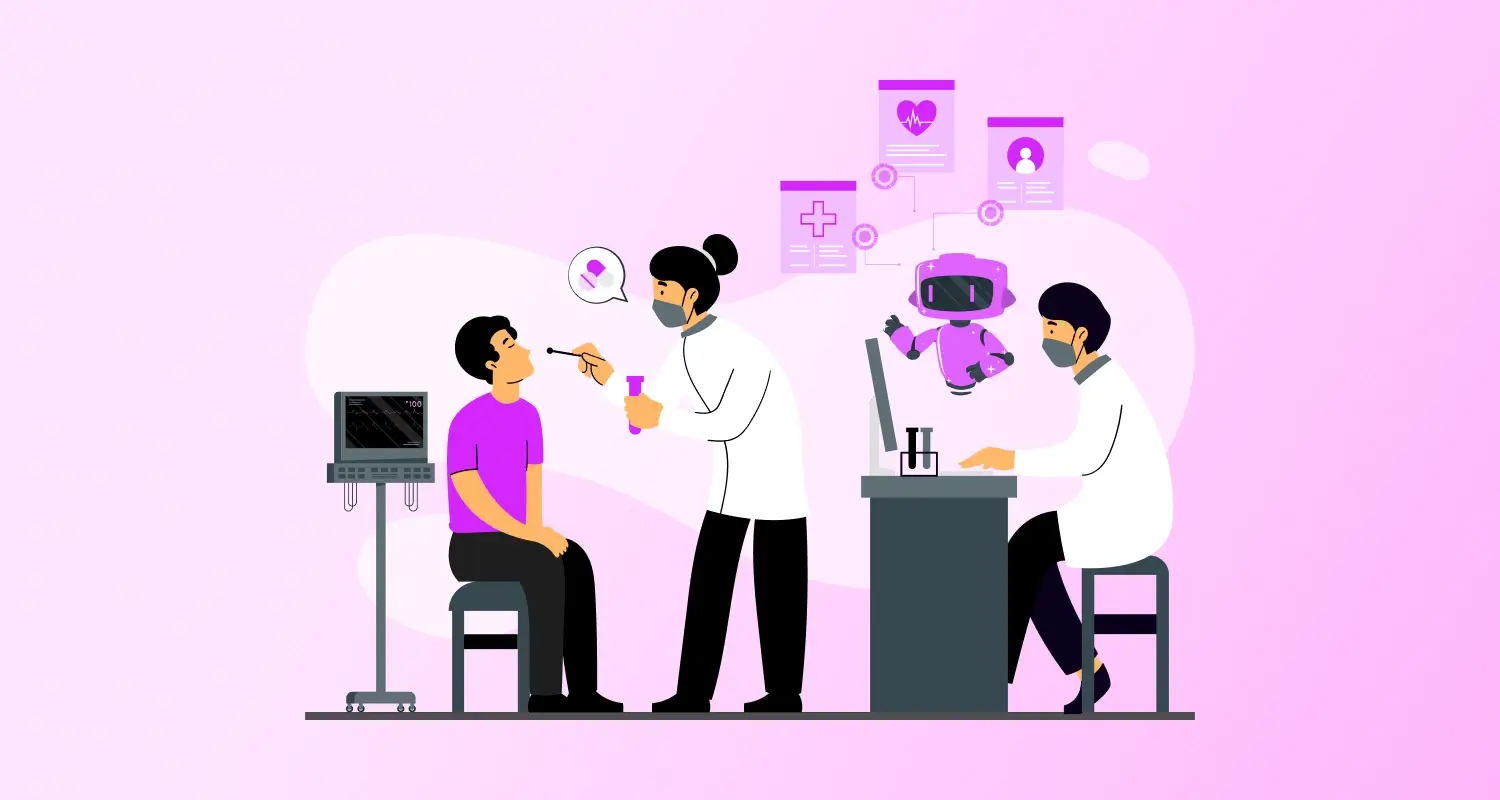The field of artificial intelligence (AI) has made revolutionary strides in the quickly changing technological world of today. One of the most fascinating subsets of AI is generative AI.
This cutting-edge technology opens up countless possibilities in data science by concentrating on creating new data rather than just analyzing old data. Data analytics and its applications have undergone a paradigm change thanks to generative AI solutions. You can get replies in text, image, audio, or any other format you’d like with only a few prompt words.
In this blog, we shall delve more into the tenets and frameworks of generative AI in data analysis applications. We’ll also talk about the potential and difficulties that come with implementing the technology and the direction that Gen AI is headed in.
What is Generative Tech?
The distinctive ability of generative AI to produce new material in a variety of disciplines, including language, music, graphics, and computer code, sets it apart from standard AI. Generative AI explores the creative space by producing new data based on patterns discovered from enormous datasets, in contrast to traditional AI systems that depend on analyzing pre-existing data.
The Functions of Generative AI
Advanced deep learning models like Variational Autoencoders (VAEs) and Generative Adversarial Networks (GANs) are the foundation of generative business intelligence. These complex models explore the distribution of data in great detail, producing new instances that reflect the underlying patterns found in the original data. Through the use of vast amounts of data, Generative AI expands the frontiers of imagination and inventiveness.
Generative Adversarial Networks (GANs)
Note that this technology is not a recent development. However, generative AI had the potential to get to a point in 2014 that was comparable to its current state. One of the most well-known methods in Gen AI is the Generative Adversarial Network (GAN), which was first developed by Ian Goodfellow and his associates.
Variational Autoencoders (VAEs)
Variational Autoencoder (VAE) is an additional widely used generative modeling tool. To set itself apart from conventional autoencoders, VAE uses encoder-decoder architecture, a concept that was proposed at Google & Qualcomm.
The decoder network reconstructs the raw data back into the original data space after the encoder converts it into a probability distribution with a lower-dimensional latent space. This is extremely helpful for creating data for AI training or realistic human faces.
Generative AI Data Analytics
When it comes to utilizing Generative AI to enhance their analytical skills, data scientists are essential. Data scientists can improve the quality of their analytical models and get around data limits by utilizing Generative AI to produce synthetic datasets that resemble real data features. This method allows data scientists to investigate a wider range of theories while also speeding up the model training process.
Let’s examine some of the primary roles that Generative AI investigates in the field of data analytics:
Enhanced Preprocessing and Augmentation of the Data
The process of turning raw data into a form that may be consumed for additional analysis is known as data preparation. This is a complicated procedure that requires many processes, including data cleansing, transformation, reduction, and normalization.
Generating Information for Model Training
Synthetic data that closely resembles the underlying dataset can be produced via generative AI. This can be applied in situations when there are privacy restrictions or little data. ML models can be trained using the generated synthetic data. This protects the privacy of data and enables businesses to use big datasets for training, producing reliable models.
Automate Issues Related to Analytics
Repetitive jobs can be seen in many business intelligence and data analytics tasks. It can be completed using automated programs, but coding takes time. The procedure can be automated with generative AI.
Chatbots, for instance, one of the applications of Gen AI, can write customized automation scripts for data extraction. When gathering data, it can additionally filter out pertinent information depending on the specified parameters.
Improved Information Display
An essential element in the data analytics process is data visualization. Developing interactive graphs, dashboards, and charts guarantees enhanced decision-making and stakeholder participation. AI in UX design has now helped many designers enhance their design skills.
Key Applications of Generative AI in Data Analytics
The following are some of the main generative AI business applications:
Analytics for Predictive
Organizations can use generative AI to analyze large datasets, identify patterns and trends, and provide accurate projections. For example, a business can anticipate customer attrition rates or stock prices to obtain valuable insights and spot developing trends.
Processing of Natural Language (NLP)
Generative AI has significantly disrupted the field of natural language processing. There are many uses for generative models since they can comprehend and produce text that resembles that of a human. The use of Azure AI services helps in building natural language understanding capabilities. For instance, chatbots for feedback. content generation and translation.
Image Recognition
Systems employ generative artificial intelligence (AI) in image synthesis and recognition. This can assist in producing artistic works, improving low-resolution photographs, and producing realistic visuals.

Challenges and Limitations of Generative AI
Great potential for the present and the future of Generative AI has been demonstrated. Adoption of it might completely change the way we operate. However, there are difficulties and barriers involved.
Considering that organizations are using technology more than ever, the following are some things to think about:
Ethical Considerations
Organizations must guarantee that data generation adheres to ethical norms and legal requirements. AI-generated deepfake photos and videos are a big worry these days. It is necessary to implement new frameworks and rules to reduce ethical risks.
Generative AI Model Biases
Similar to other ML models, generative AI is vulnerable to biases in the training set. Inconsistencies and problems with accuracy arise in the output data due to biased input.
Security and Privacy of Data
For heavily regulated sectors like healthcare and finance, data security and privacy are top priorities. Companies need to put safeguards in place to guard against data breaches, abuse, and illegal access.
Explainability and Interpretability
Understanding how huge datasets are trained to generate data using generative AI models powered by neural networks can be difficult.
To explain results and foster confidence in their work, organizations should make sure elements include explainability and interoperability in use.
Top Tips for Using Generative AI – Best Practices to Follow

High-Quality Data
Businesses need to make sure that generative AI models are trained on diverse, high-quality data. Both first-party and third-party data from reliable sources are acceptable. To enhance generative AI for data analytics and eliminate any inaccurate data, organizations need also clean and prepare their data.
Using AI-Integrated Tools
Many technologies, most notably ChatGPT, have generative AI built in to help automate and optimize data analytics tasks.
The following are a few well-known data analytics solutions that incorporate generative AI:
- Power BI: One of the most widely used tools for data visualization is Power BI generative AI, which offers Copilot access to AI insights. By presenting data in clear, basic terms, you may analyze it and generate reports. Additionally, Microsoft Fabric is an AI-powered unified analytics platform.
- TableauGPT: Tableau GPT, which is powered by Einstein GPT, incorporates automation into all aspects of analytics, including data governance and preparation. Tableau Pulse is an application that uses Tableau-GPT to extract insights from data that can be put to use.
- Jupyter AI: To assist users in creating programming and troubleshooting difficulties, Jupyter Notebook incorporates generative AI capabilities. The coding assistance can also be used by users to finish codes, saving time and increasing output.
- Notion AI: ChatGPT technology is integrated to produce documents, summarise information for users, and highlight important details from notes.
Transparency
To abide by legal requirements and protect user privacy, organizations must guarantee data transparency and explainability. Additionally, you want to implement safeguards against biases and hazards in generative AI models.
Privacy Impact
Safeguarding sensitive and confidential information is crucial while employing gen AI. Throughout the data analytics process, including data collecting, storage, and sharing, organizations should identify possible risks to user privacy and take appropriate action to mitigate them.
Data Security Protocols
When thinking about an ethical approach to the deployment of gen AI, data security is yet another essential component of best practices. Systems using Gen AI should be guarded against security risks and kept an eye out for illegal access. Regular protocol updates and data encryption are further ways to reduce risks.
Opportunities for Generative AI in the Future- Use Cases
Looking ahead, it seems like there are countless possibilities with generative AI. With the help of this technology, data scientists will be able to more accurately draw useful insights and adjust to changing data environments, potentially revolutionizing the field of analytics. Organizations may maintain their competitive edge by utilizing the potential of Generative AI.
Medical Imaging
Data privacy concerns have limited the amount of medical imaging data that healthcare organizations can use to train machine learning models. Generative AI techniques can be used to create synthetic versions of real-world data. To improve patient outcomes and clinical decision-making, this helps to train trustworthy diagnostic models.
Product Endorsements
Retailers that analyze customer data can offer recommendations tailored to individual users. To deliver recommendations that are specific to a user’s needs, generative AI models can be trained on their browsing patterns and purchase histories. Conversion rates and customer satisfaction both increase as a result.
Fraud Identification
Generative AI can produce data that resembles expected behavior when compared to real-world data, making it possible to spot anomalies and fraud. This can help businesses in several industries, such as retail, healthcare, and finance, lower risks and prevent fraud.
Conclusion
In the field of data science, generative AI is a game-changer that fosters creativity, innovation, and better decision-making. Data scientists can push the limits of what is feasible in the field of data analysis by going on a voyage of exploration and discovery by comprehending and using the power of generative artificial intelligence.
At CMARIX- an AI software development solutions company, we have extensive experience developing intelligent software and solutions by utilizing machine learning and artificial intelligence. Get in touch with us right now if you need developers to help with the creation of your solution!
Frequently Asked Questions
How Generative AI Can Be Used in Real-Time Applications?
Generative AI is used in various applications that help in industries like healthcare, medicine, genomic analysis, finance, marketing and design, manufacturing, entertainment, and much more.
How Does Generative AI Integrate with Existing Data Science Workflows?
By either automatically creating more enhanced training data or by developing an internal representation of the data that makes it easier to train AI models with less labeled data, generative AI models can lower the cost of labeling.
Can Generative AI Improve the Accuracy of Machine Learning Models?
The primary idea is that GenAI models are capable of learning relationships and patterns in a dataset to the extent necessary to produce new text, images, videos, and audio while maintaining adherence to the underlying patterns. The conditional model’s overall performance can be enhanced by applying the generative AI model to increase the label accuracy.
What Are the Challenges of Implementing Generative AI in Data Science?
Data security and privacy are two major issues that businesses may run into while deploying generative AI. Large data sets are essential for generative AI models to produce results that are precise and significant. However, managing that much sensitive data might raise issues with security and privacy.







